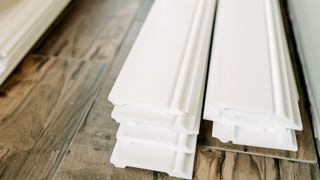Sanding skirting boards: How to get your preparation spot on
Sanding skirting boards is a key part of the prep process for paint, varnish or stain. Here we tell you why, how and what you will need to get a great finish

Sanding skirting boards is the first step towards giving them a professional finish to fit in perfectly with your brand new decor — it doesn't matter if they are old or new, it is still a task worth doing before painting.
Of course, if you don’t do your preparation properly the finish won’t look as smart and it will be more susceptible to knocks and chips.
When working with skirting boards,sandingthose rough edges is essential in getting the best finish. You’ll need to choose and right grit sandpaper, the right technique and the right tools, all revealed in this in-depth guide.
Sanding skirting boards: Why you need to sand them
Skirting boards by their very nature are there to protect the bottom of walls from kicks and hits and keep the plaster and wallpaper in good condition, as well as hiding the unsightly gap between the floor and plaster. This means that they need to be painted regularly to keep them looking their best. Preparation is key, so sanding with the right combination of sandpaper and technique is essential for the best finish.
Whether you aresanding wood by handor using a power sander, sanding has a two-fold purpose. First it will get rid of any imperfections such as paint runs and help hide chips. Second, it will rough up the surface, whether it's bare wood or old paint and provide better adhesion. If not sanded properly the paint or varnish is more prone to chipping and will be in need of a repaint sooner than expected.
What is the easiest way to sand skirting boards?
This depends on the style and size of the skirting board and if it has been painted previously. If you are sanding chamfered, rounded or bullnose skirting — boards with mainly flat surfaces — you can use a detail sander like thisBlack+Decker Corded Detail sander from B&Q. You can use an orbital sander or sheet sander, but a detail sander is a better fit for the job, especially on shorter (height) skirting boards.
A detail sander has a small sanding pad making it easier to work on skirting boards. Alternatively, you can use a sanding block or a scrap of wood to wrap the sandpaper around and sand the wood by hand.
If sanding skirting boards with more intricate moulding or designs like thisKOTA White MDF Torus Skirting boardandMetsä Wood Primed White MDF Ogee Skirting board from B&Qyou’ll need to sand by hand or use a combination of hand and detail sander. Use the sander to do the flat areas and hand sand to do the more intricate areas. Try sanding sponges like these multi-gritsanding sponges from Amazonas they mould to the shape of the wood.
What grit do I need for sanding painted skirting boards?
If you are sanding bare wood skirting boards or new MDF skirting boards there shouldn’t be any heavy duty sanding involved. So you will only need a fine gritsandpaper gradelike 220 grit for an initial sand and in between each coat of paint or varnish.
If you are working on previously painted skirting boards, kick off with a 120 grit to get rid of any surface imperfections and finish with a 180 or 220 to get a smooth surface ready for painting.
If you want to sand previously painted skirting boards back to bare wood to start the paint process from scratch or ready for varnishing, you should start with a coarse sandpaper grit such as 60. Once you get back to bare wood, use a 120 grit to prepare forpainting skirting boardsand then 180 or 220 grit for between coats.
How do you clean skirting boards after sanding?
When sanding skirting boards it will leave dust that will need to be dealt with before you can think about adding paint or similar. Start by using a dry paintbrush — not the one you are going to paint the skirting boards with — and brush the skirting board in one direction making sure to get in any crevices.
Once the skirting board is dust-free, get a vacuum and remove as much dust as possible. Finally, get a damp cloth and wipe over the skirting board and leave to dry, ready for adding your chosen finish.

Can MDF skirting board be sanded?
Yes. MDF skirting board typically comes ready primed negating the need to do an initial sanding on bare MDF. However, while the primer makes it easier to paint, you will still need to sand between coats.
MDF is made up of compressed fibres so it is the ends that need the most attention whensanding MDF. But when dealing with, and installing MDF skirting boards, the edges will not be seen, so won't need to be sanded for aesthetic reasons.
Get the Homebuilding & Renovating Newsletter
Bring your dream home to life with expert advice, how-to guides and design inspiration, direct to your inbox.
Steve is Homebuilding & Renovating's DIY content editor, and has been a writer and editor for two decades. He is an avid DIYer with over 20 years of experience in transforming and renovating homes. He specialises in painting and decorating, but has strong all-round building skills, having previously worked in the industry for 10 years.
Most Popular
Bring your dream home to life with expert advice, how-to guides and design inspiration, direct to your inbox.
Thank you for signing up to Homebuilding. You will receive a verification email shortly.
There was a problem. Please refresh the page and try again.
